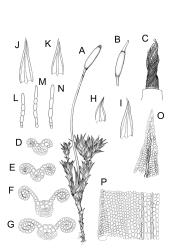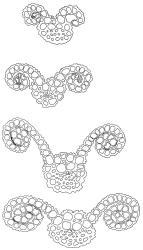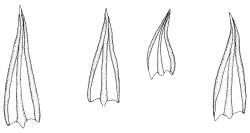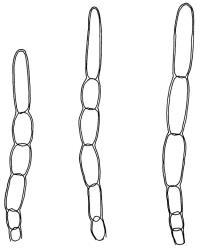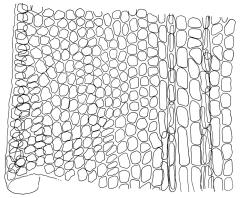- ≡ Barbula hornschuchiana Schultz in Hornschuch, Syll. Pl. Nov. 35 (1824)
Plants yellow-green, forming dense tufts. Stems to c. 7 mm, simple or occasionally branched, in cross-section with central strand present, sclerodermis weakly developed. Leaves erect-spreading when moist, incurved and somewhat twisted round the stem when dry, 0.8–1.1 mm, narrowly triangular, carinate, acuminate; margins broadly revolute throughout; upper laminal cells clear in outline, irregularly quadrate to rotund, occasionally triangular, pluripapillose with 2–4 low papillae, (6.0–)7.5–10.5(–12.0) × (6.0–)7.5–10.5(–12.0) μm; upper marginal cells not differentiated; lower laminal cells little differentiated from upper cells, juxtacostal cells at insertion rectangular and smooth. Costa concolorous, stout, excurrent in a short arista; adaxial superficial cells similar to adjacent laminal cells; abaxial superficial cells irregularly rectangular, smooth; in cross-section with 2 stereid bands. Axillary hairs of c. 6 cells, colourless throughout. Laminal KOH colour reaction yellow.
Reportedly dioicous (Catcheside 1980). Perichaetia with leaves differentiated, longer than vegetative leaves, innermost long-acuminate from an elongated erect base, and costa long-excurrent as a concolorous hair-point. Perigonia not seen. Setae slender, flexuose, reddish brown, 6–8 mm. Capsules slightly inclined, ellipsoid-cylindric, weakly arcuate, brown, darker at the mouth, with a differentiated annulus, 1.3–1.7 mm. Operculum conic-rostrate, slightly asymmetric, ⅓ the theca length with cells spirally arranged. Peristome to 750 µm when freshly exposed, pale orange, of 16 pairs of filiform rami, densely spiculose, and several times twisted to the right, from a low, tessellated, basal cylinder. Spores 6–8 µm, smooth.
Catcheside 1980, fig. 91 (a–j) (as Barbula hornschuchiana); Magill 1981, fig. 69 (20–27) (as B. hornschuchiana); Zander 1993, pl. 27 (1–5); Smith 2004, fig. 89 (1–5); Atherton et al. 2010, p. 440; Lüth 2019, p. 654; Malcolm et al. 2020, p. 569.
The yellow-green matt shoots, with triangular leaves that are broadly revolute throughout their margins, will distinguish P. hornschuchianum from all other N.Z. mosses. Such is the extent of the recurvature of the leaf margins, their rolled edges may abut on, or almost cover, the costa for the distal ¼ of the leaf. Ceratodon purpureus has narrowly recurved leaf margins that do not reach the costa. It also differs in its smooth laminal cells, and often denticulate leaf apices (vs papillose laminal cells and entire leaf apices in P. hornschuchianum). The red-purple tones and lustrous appearance often seen in C. purpureus shoots are not features of P. hornschuchianum.
Pseudocrossidium hornschuchianum could be confused with Gertrudiella torquata, but it is a smaller plant, with stems c. 7 mm, and leaves 0.8–1.1 mm (vs stems 5–25(–35) mm and leaves (1.0–)1.5–3.0 mm in G. torquata). Axillary hairs will further distinguish the taxa: all cells are hyaline in P. hornschuchianum (vs basal cell brown in G. torquata). Atherton et al. (2010), in their field guide to Mosses and Liverworts of Britain and Ireland, comment that, viewed from above, the spreading triangular leaves give the shoots "a rather star-like appearance", which is a useful field character in N.Z. also. Small plants of Chrysoblastella chilensis (Ditrichaceae), also with yellow-green matt shoots, have a very similar moist form, but there the leaf margins are plane.
NI: Hawke’s Bay, Wellington; SI: Canterbury, Otago.
Almost certainly introduced. Widespread in temperate regions of both hemispheres, but considered to be introduced in the U.S.A. and Canada (Zander 1993), in Chile (Müller 2002), and perhaps in Australia (Catcheside 1980).
All N.Z. collections of Pseudocrossidium hornschuchianum are from sites of anthropic disturbance: roadside drains, urban parks, cemeteries, and motel grounds, for example. The substrate is usually soil, frequently where weedicide has been applied. It has been found as very small shoots in cracks in concrete or brick paths. This moss is associated with a wide range of other weedy species, including Barbula unguiculata, Bryum argenteum, B. dichotomum, Calliergonella cuspidata, Ceratodon purpureus, Gertrudiella torquata, Pseudocrossidium crinitum, Trichostomopsis australasiae, and Triquetrella papillata.
Records range from c. 10 to 350 m elevation (Mt Cameron, Hawke’s Bay L.D.).
The earliest confirmed N.Z. collection was made by K.W. Allison in 1962 in the Napier Botanical Gardens (CHR 570655), and identified by him as a "slender form" of Gertrudiella torquata (as Barbula torquata). In 1993, P. hornschuchianum was collected several times by visiting Dutch bryologists B.O. van Zanten and P. Sollman, and N.Z. bryologists were then alerted to its presence (van Zanten & Sollman 2023).
Due to the earliest known collection having been made less than 60 years ago, and the anthropic nature of its habitat, the species is regarded as introduced to N.Z. It may be more common than present records indicate but overlooked owing to a superficial resemblance to both Ceratodon purpureus and Gertrudiella torquata, and to the rarity of capsules.
Pseudocrossidium adustum (Mitt.) M.J.Cano, a species with similarities to both P. crinitum and P. hornschuchianum, has been recorded in Australia and South Africa (Cano 2011). It has not been recorded in N.Z.




